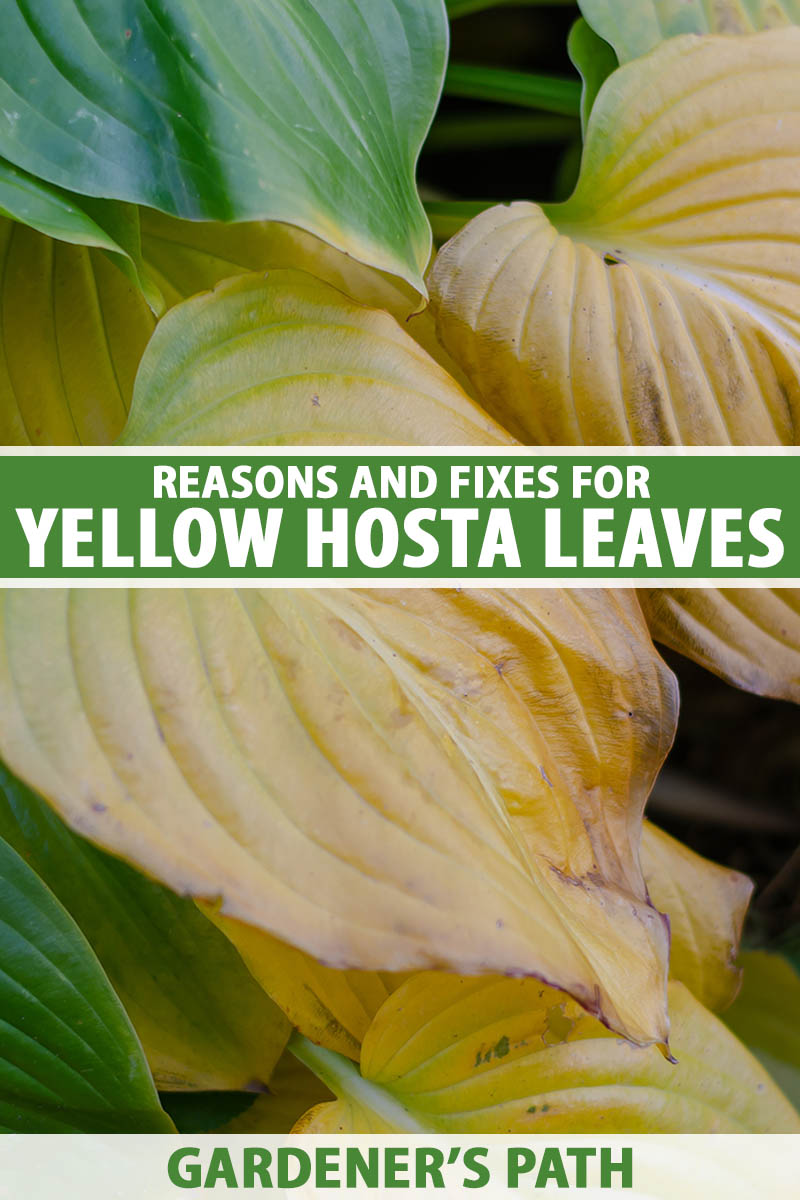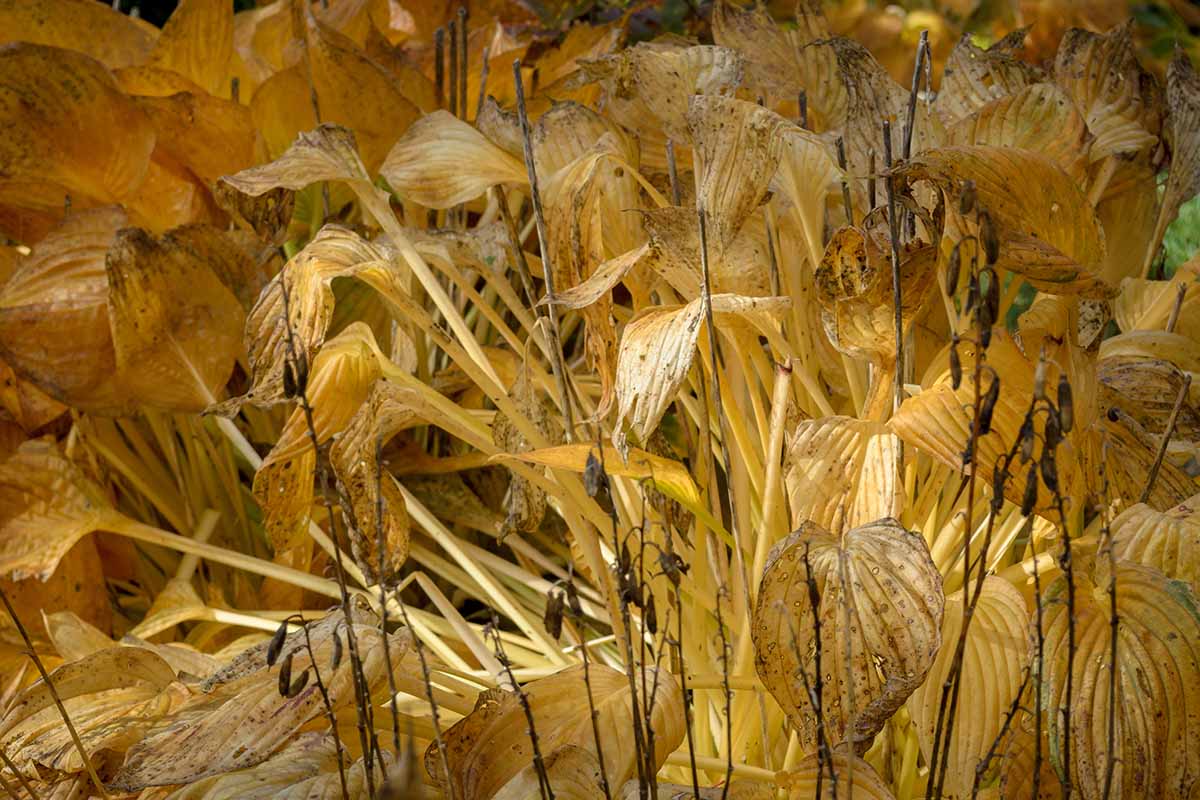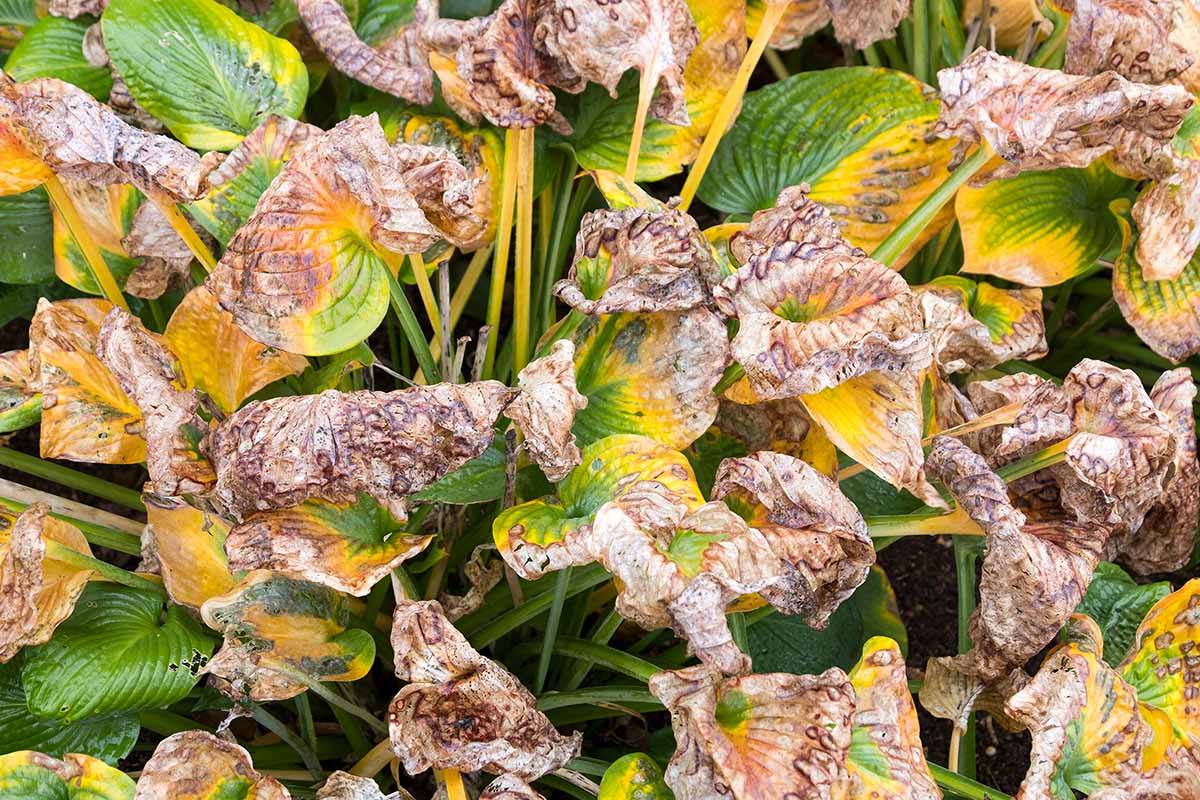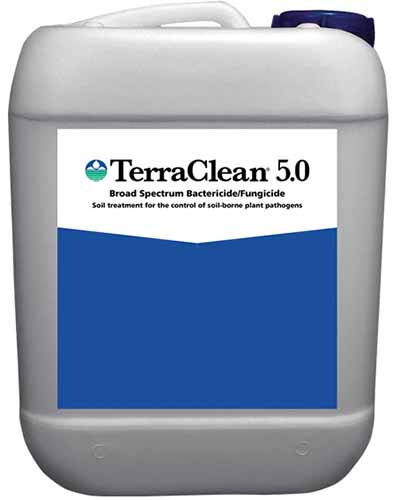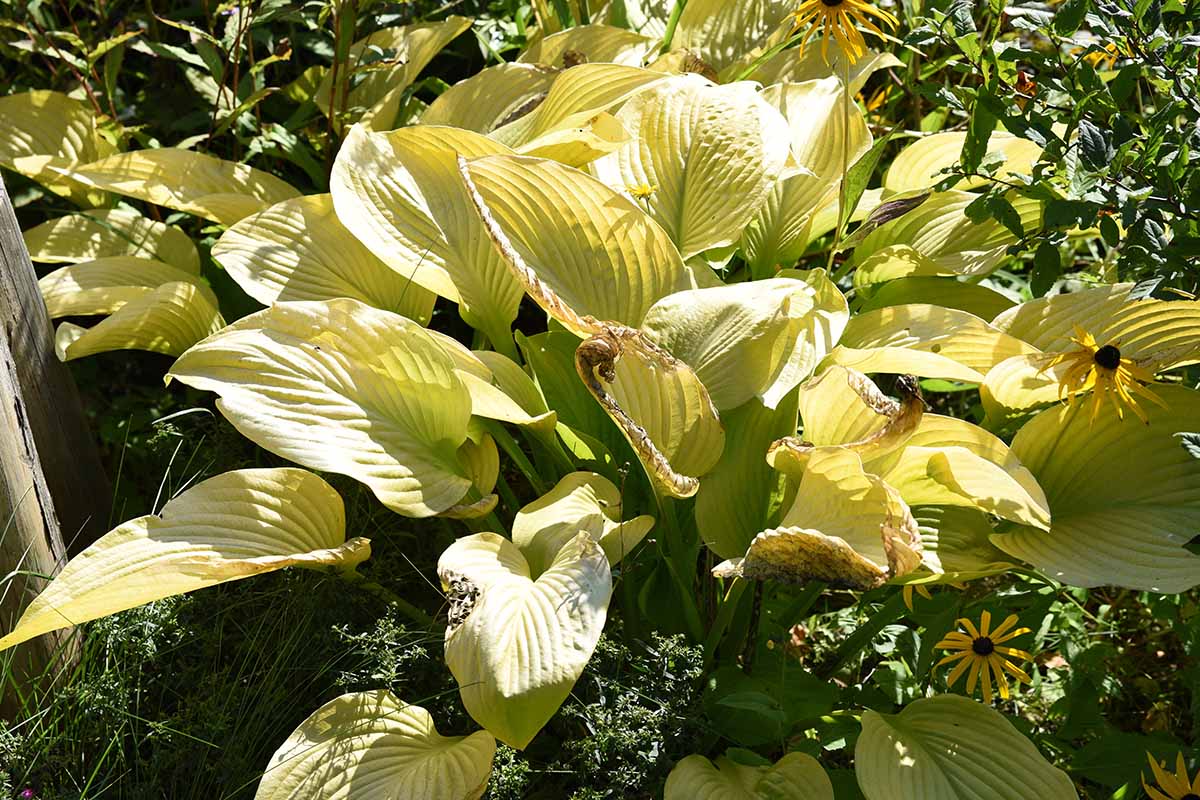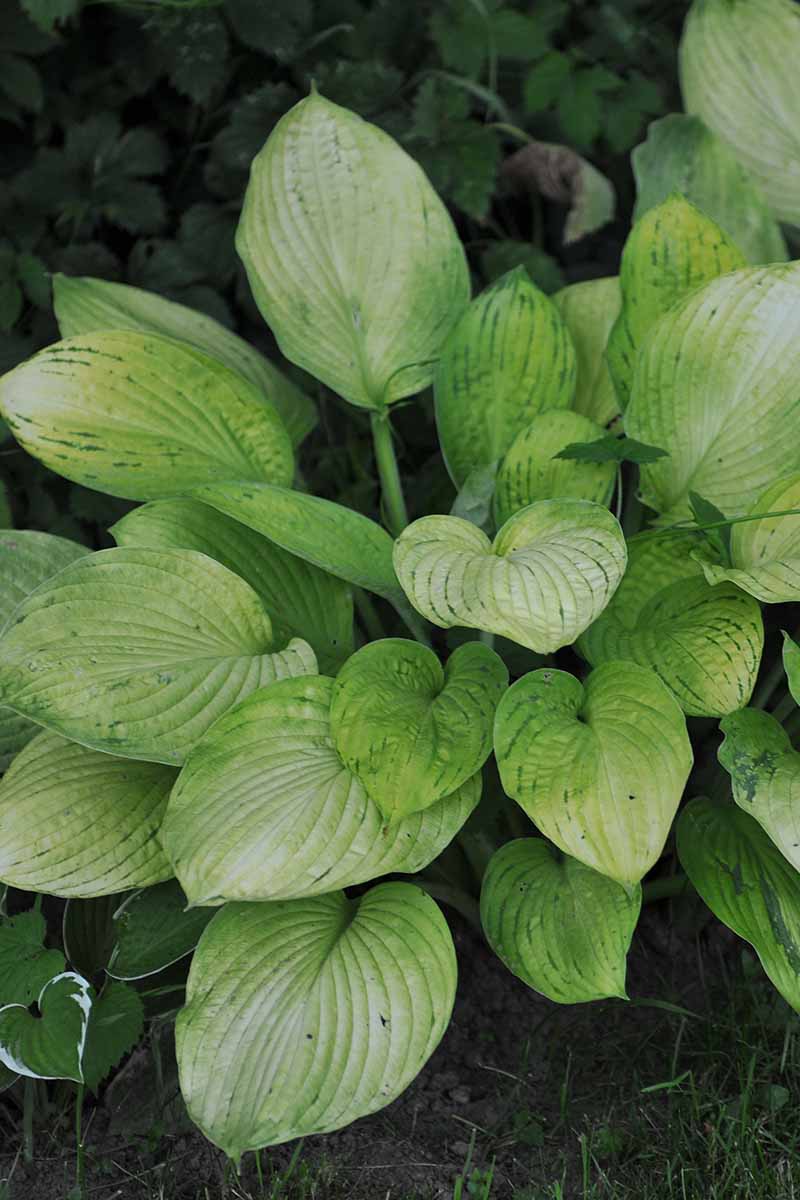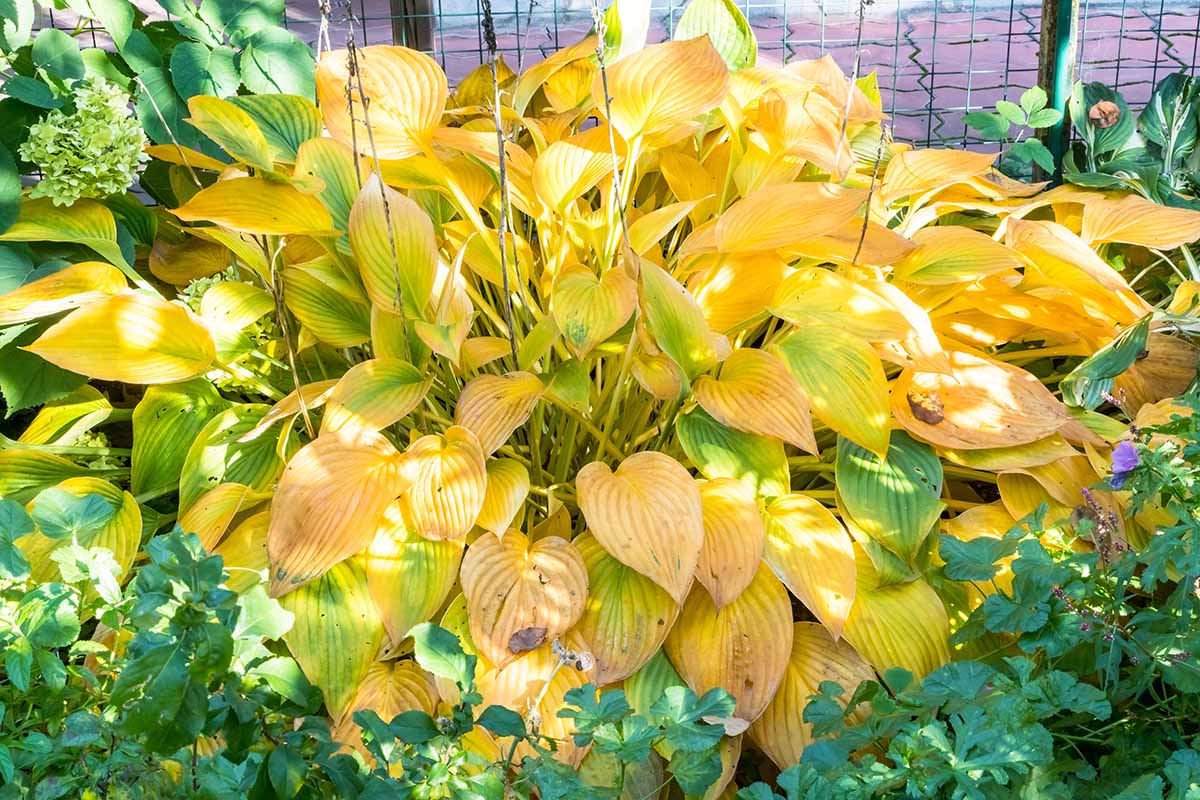The good news is that there are lots of ways to fix the issues that can cause the foliage on your hostas to turn yellow. The bad news is that it can be difficult to tell what’s causing the problem in the first place. We link to vendors to help you find relevant products. If you buy from one of our links, we may earn a commission. Ready? Here’s everything that’s coming up: Don’t panic, yellow leaves aren’t necessarily a death sentence. Sometimes it just means you need to make some adjustments, or give your plant a little extra care.
1. Bacterial Rot
If the lowest leaves on your plant are turning yellow before becoming mushy and dying, take heed. It might be infected with bacterial soft rot. Caused by species in the Erwinia genus, this disease causes the petioles to start rotting. If you give them a sniff, they’ll stink like rotting vegetables. Any time when your hosta is injured by frost, pruning, insects, or accidental damage, it may be prone to infection by the bacteria that cause this disease. Poorly draining soil, high humidity, and temperatures over 80°F also increase the chances that these disease pathogens will be hanging out in the vicinity. Sadly, there’s nothing you can do once this disease starts doing its thing. Pull infected plants, and do your best to avoid this ailment next time.
2. Dormancy
I’m sure you already know this, but hostas turn pale when they go dormant in the late fall or early winter. If you’ve had a hard freeze, it should come as no surprise if the foliage turns yellow and eventually becomes mushy. However, if you’re having a dry fall or some other source of stress plagues your plants, they might go into early dormancy. It can be hard to tell if yellowing is caused by pending dormancy or something else, but look at the leaves to see if they are wilting, turning brown, and collapsing. This is all part of the normal process, as the weather turns cold. If the leaves remain upright and firm but turn yellow, or if only some of the leaves turn yellow but not all of them, then it might be the result of something else on this list.
3. Fusarium
A disease caused by fungi in the Fusarium genus sometimes manifests in yellow foliage. Typically, you’ll see leaves turning yellow and brown at the tip first before progressing down the entire leaf. It also causes stunted growth. To do this, remove a leaf and cut it open so that the yellow part is split open. Put some water on a clear piece of glass or in a clear drinking glass, and place the cut edge of the leaf so it makes contact with the water. To avoid Fusarium infection in the first place, sanitize your tools in a one part bleach to nine parts water mixture before using them in the garden. Then, use a pre-planting dip that contains hydrogen dioxide and peroxyacetic acid when you divide your hostas or plant new seedlings. Then, soak the seedlings again with the same product a day after placing them in the ground. There’s no need to re-apply if you’re dividing plants. TerraClean 5.0 You can pick up a five-gallon container of TerraClean 5.0 at Arbico Organics.
4. Foliar Nematodes
There are several unwelcome varieties of nematodes, all in the Aphelenchoides genus, that can turn your hosta leaves from happy green to sickly and sad. Beginning with small yellow lesions that are limited in size by the leaf veins, these symptoms look a lot like leaf scorch at first. As things progress, the leaves turn yellow, then brown, and then die. Before you freak out and pull your hostas, test to see if you have nematodes first. After about 30 minutes, shine a flashlight under the glass or hold the glass over a lamp and look closely for tiny, wiggly, snake-like shapes in the water. These are your nematodes. Unfortunately, there isn’t a great way to treat the problem other than removing infested leaves, and watering at the soil level rather than on the foliage going forward. They’ll still be around, but you can limit the damage they cause. This is known as tolerance, which is the act of learning to live with a disease or pest rather than eliminating it. Just know that the nematodes will likely spread to every hosta in your garden and to some other species, as well. If you just can’t tolerate those ugly leaves, pull the plants and dispose of them. Don’t plant hostas or ferns there for a couple of years and the nematodes will die off on their own.
5. Light Exposure
Certain hostas will turn lighter in color when they don’t receive the amount of sunlight they prefer. Dark green hostas, for instance, will exhibit a lighter green or yellow color if they’re exposed to too much light. On the other hand, yellow or white hostas may turn green if they don’t receive enough sun, so it all depends on the type that you’re growing. Other times, the leaves can develop yellow splotches that look sort of like they’ve been burned or bleached. This is sun scorch, and it happens when a plant suddenly receives too much sun, as may occur when the position of the sun changes and suddenly light is reflecting off your windows and onto your plants. Or maybe a tree branch breaks, leaving your plants exposed. To test to see whether sun exposure is turning your plants the wrong color or causing scorch, try covering them with some shade cloth temporarily. If things start to improve, you should move your hostas to a more suitable location.
6. Over-Feeding
Hostas don’t need a ton of nutrients during the growing season. Too much food can actually cause the foliage to start turning pale yellow. You won’t see any spots, but you will see yellowing, browning, or burnt foliage. If you aren’t sure how to tackle feeding, our guide to growing hostas can provide some guidance.
7. Petiole Rot
The disease formerly known as stem and crown rot causes the leaves to start turning yellow at the margins before extending through the rest of the leaf. As the disease progresses, you’ll see rot and fungal threads at the base of the plant. Eventually, the entire base of the plant will rot and collapse. Caused by Sclerotium rolfsii var. delphinii, this fungus thrives in warm temperatures ranging from 80 to 90°F, during periods of wet weather. It is spread via plant matter, soil, and garden tools. It also spreads through water, which means any time you irrigate or it rains, there is potential for the disease to spread. If you want to avoid this disease, plant resistant cultivars such as ‘Halcyon,’ ‘Honeybells,’ ‘Snow Mountain,’ ‘Tall Twister,’ and ‘Zounds.’ ‘Lemon Lime,’ ‘Munchkin,’ ‘Nakaiana,’ ‘Platinum Tiara,’ ‘Serendipity,’ and ‘Tardiflora’ are susceptible, so these should be avoided if petiole rot is a known problem in your area. Always be careful to clean your tools and examine any plants when you buy them to ensure that they aren’t infected. If you find evidence of this disease in the garden, pull all of the infected plants and destroy them. Then, remove the soil where the plants were growing to a depth of at least six inches and get rid of it. Replace it with clean soil.
8. Viruses
There are several different viruses that can impact these plants and many of them cause chlorosis. Hosta virus X (HVX) causes angular patches of yellowing, while tomato ringspot virus (ToRSV) causes large circular patches of yellow. Tobacco rattle virus (TRV) causes the leaves to fade to a pale yellow color overall. It can be hard to tell if the yellowing that you see is caused by tobacco rattle virus since many things may cause yellowing, but the symptoms of the other two viruses are more distinct. You can send in your plants to the local extension office for testing if you like, and they can confirm the presence of specific types of disease. If you do have a virus present, the only way to control it is to get rid of the plants. While the virus might not kill your plants, making it tempting to leave them in place, you run the risk of spreading the disease to other specimens in your garden, including your veggies. Prevention involves keeping insects out of the garden that may spread viruses, and keeping your tools clean.
9. Watering Issues
Both overwatering and underwatering can cause yellowing, though with different symptoms. Overwatering causes the entire leaf to turn yellow and start to droop. Underwatering causes the leaves to turn dry brown and yellow, usually starting at the tip. Most hostas want constantly moist soil but they aren’t able to tolerate standing water. Read our guide to figure out how to provide the right amount of moisture to your hostas. (coming soon!) Yellow leaves are like little flags warning you that something is wrong. Your job is to study the symptoms and do a little detective work to figure out what’s causing your woes. Hopefully, this guide helped you do that. If so, let us know what you’re dealing with and how you handled it in the comments below. Or, if you’re still having trouble, give us a heads up and we’ll see what we can do to help. Feel free to share photos of the symptoms that you’re seeing as well! If you’re looking for tips on keeping your hostas as happy as possible, we have a few guides that can steer you in the right direction. You might want to check out some of these next:
Keep or Cut: How to Make the Most of Hosta FlowersHow to Grow Hostas in Containers19 Favorite Hosta Varieties
